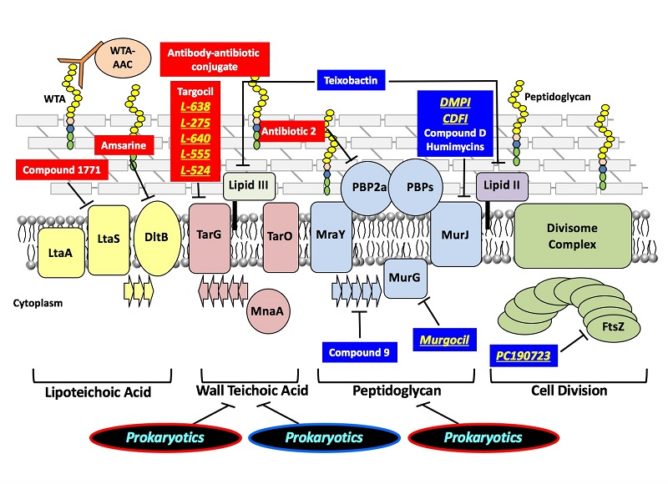Prokaryotics Novel Target Approaches
Each of Prokaryotics’ antibiotic development programs uniquely target distinct cell surface and fundamentally essential biochemical assembly components of the Gram-negative outer membrane; an intrinsic barrier produced by Gram-negative bacteria which naturally restricts antibiotic entry and ultimate efficacy. We believe targeting a circuitry of interdependent cellular processes required for outer membrane biogenesis provides a timely and robust opportunity to develop next generation antibiotic agents effective on their own or in combination with existing agents to provide effective monotherapeutic or synergistic efficacy against drug-resistant bacteria.

This diagram illustrates select Gram-positive cell-wall associated targets and cognate inhibitors, including Prokaryotics’ agents (black ovals), compounds discovered by Prokaryotics’ founder Terry Roemer (highlighted in yellow, underlined text), and compounds discovered by others (white text). Biologically relevant biosynthetic pathways: lipoteichoic acid (yellow); wall teichoic acid (salmon); peptidoglycan (blue); cell division (green). The potential antimicrobial spectrum for the reported inhibitors is designated: potential broad Gram-positive spectrum (red box/outlined oval); potential broad Gram-positive and Gram-negative spectrum (blue box/outlined oval).

This diagram illustrates select Gram-negative OM-associated targets and cognate inhibitors, including Prokaryotics’ agents (black ovals) and compounds discovered by others (white text). Biologically relevant biosynthetic pathways: lipopolysaccharide transport pathway (salmon), lipoprotein processing and assembly (yellow), and OMP assembly (purple). The potential antimicrobial spectrum for the reported inhibitors is designated: potential broad Gram-negative spectrum (green box/outlined oval); potential broad Gram-positive and Gram-negative spectrum (blue box/outlined oval). OM outer membrane, IM inner membrane, PG peptidoglycan, PL phospholipid, LPS lipopolysaccharide, OMP OM β-barrel protein.
How we Think...
Systems-Level Antimicrobial Drug and Drug Synergy Discovery. Nature Chemical Biology (2013)
Antibacterial New Target Discovery: Sentinel Examples, Strategies and Surveying Success. Springer-Verlag book series “Topics in Medicinal Chemistry” on the topic of “The Future of Antibiotics” (2017)
How we Screen...
Selective Small Molecule Inhibition of an RNA Structural Element. Nature (2015)
TarO-specific inhibitors of wall teichoic acid biosynthesis restore β-lactam efficacy against methicillin-resistant staphylococci. Science Translational Medicine (2016)
Discovery of Novel Wall Teichoic Acid Inhibitors as Effective anti-MRSA b-lactam Combination Agents. Chemistry & Biology (2013)
Genome-wide Fitness Test and Mechanism-of-Action Studies of Inhibitory Compounds in Candida albicans PLoS Pathogens (2007)
How we Discover Targets...
Chemical Genetic Analysis and Functional Characterization of Staphylococcal Wall Teichoic Acid 2-Epimerases Reveals Unconventional Antibiotic Drug Targets. PLoS Pathogens (2016)
Restoring Methicillin-resistant Staphylococcus aureus Susceptibility to β-lactam Antibiotics. Science Translational Medicine (2012)
Chemical Genetic Interaction Networks Re-sensitize Methicillin Resistant Staphylococcus aureus to B-lactam Antibiotics. Chemistry & Biology (2011)
How we Validate Druggable Targets...
Dual Targeting Small Molecule inhibitors of the Staphylococcus aureus FMN Riboswitch Disrupt Riboflavin Homeostasis in an Infectious Setting. (Wang H, Mann PA, Xiao L, Gill C, Galgoci AM, Howe JA, Villafania A, Barbieri CM, Malinverni JC, Sher X, Mayhood T, McCurry MD, Murgolo N, Flattery A, Mack M, Roemer T. Cell Chem Biol (2017) May 18;24(5):576-588.e6. doi: 10.1016/j.chembiol.2017.03.014. Epub 2017 Apr 20. PMID: 28434876)
Murgocil is a Highly Bioactive Staphylococcal-Specific Inhibitor of the Peptidoglycan Glycosyltransferase Enzyme MurG. ACS Chemical Biology (2013)
Chemical Genomics-based Antifungal Drug Discovery: Targeting Glycosylphosphatidylinositol (GPI) Precursor Biosynthesis. ACS Infectious Diseases (2015)
Where we are Going...
A small-molecule inhibitor of BamA impervious to efflux and the outer membrane permeability barrier. Hart EM, Mitchell AM, Konovalova A, Grabowicz M, Sheng J, Han X, Rodriguez-Rivera FP, Schwaid AG, Malinverni JC, Balibar CJ, Bodea S, Si Q, Wang H, Homsher MF, Painter RE, Ogawa AK, Sutterlin H, Roemer T, Black TA, Rothman DM, Walker SS, Silhavy TJ. Proc Natl Acad Sci USA (2019) Oct 22;116(43):21748-21757. doi: 10.1073/pnas.1912345116. Epub 2019 Oct 7. PMID: 31591200
Distinctive roles for Periplasmic Proteases in the maintenance of essential outer membrane protein assembly. Journal of Bacteriology (2017)
Characterization of a stalled complex on the β-barrel assembly machine. Proceedings of the National Academy of Sciences USA (2016)
Disruption of lipid homeostasis in the Gram-negative cell envelope activates a novel cell death pathway. Proceedings of the National Academy of Sciences USA (2016)
Lipopolysaccharide transport and assembly at the outer membrane: the PEZ model. Nature Reviews Microbiology (2016)
β-Barrel membrane protein assembly by the Bam complex. Annual Review of Biochemistry (2011)
The bacterial cell envelope. Cold Spring Harbor Perspectives in Biology (2011)
